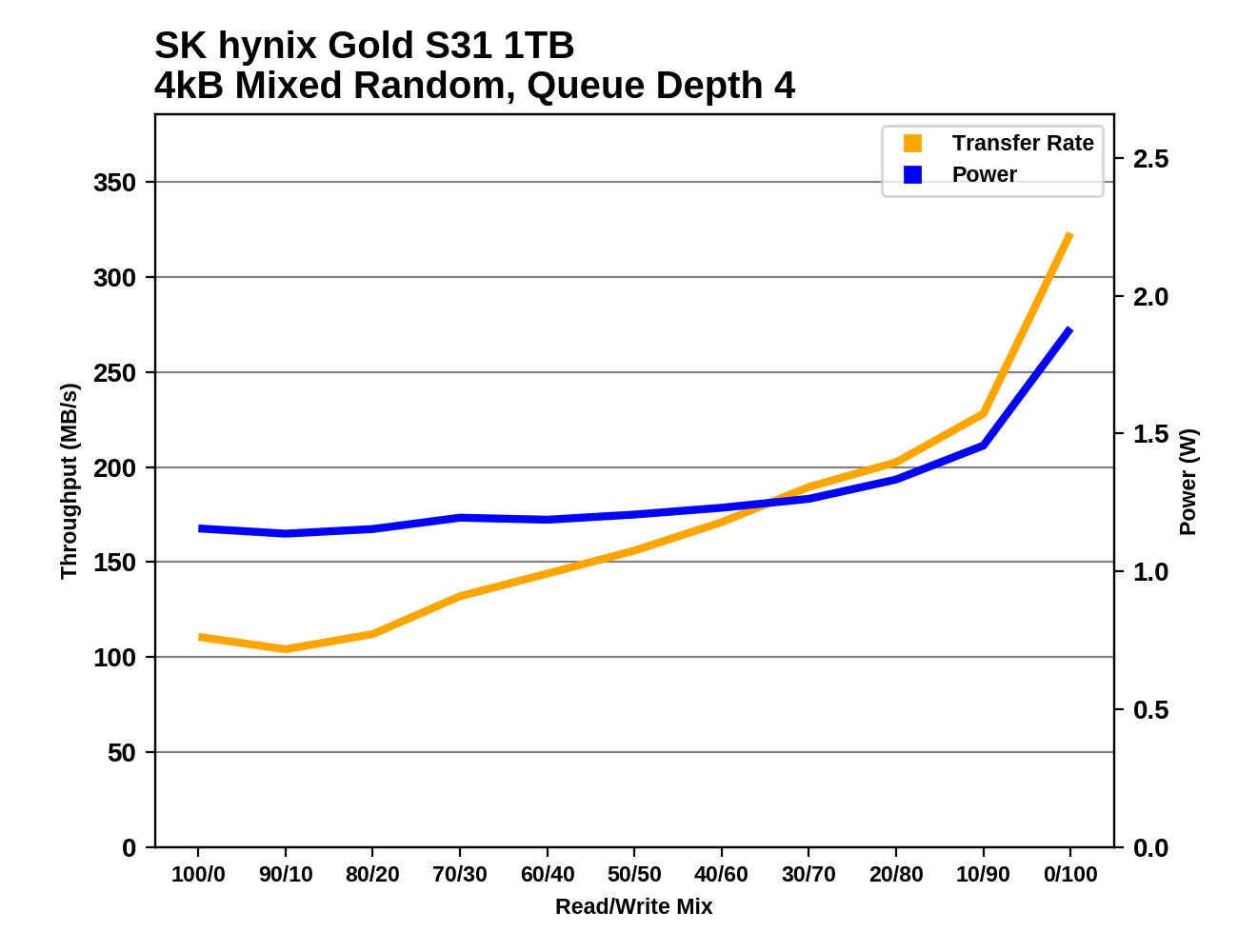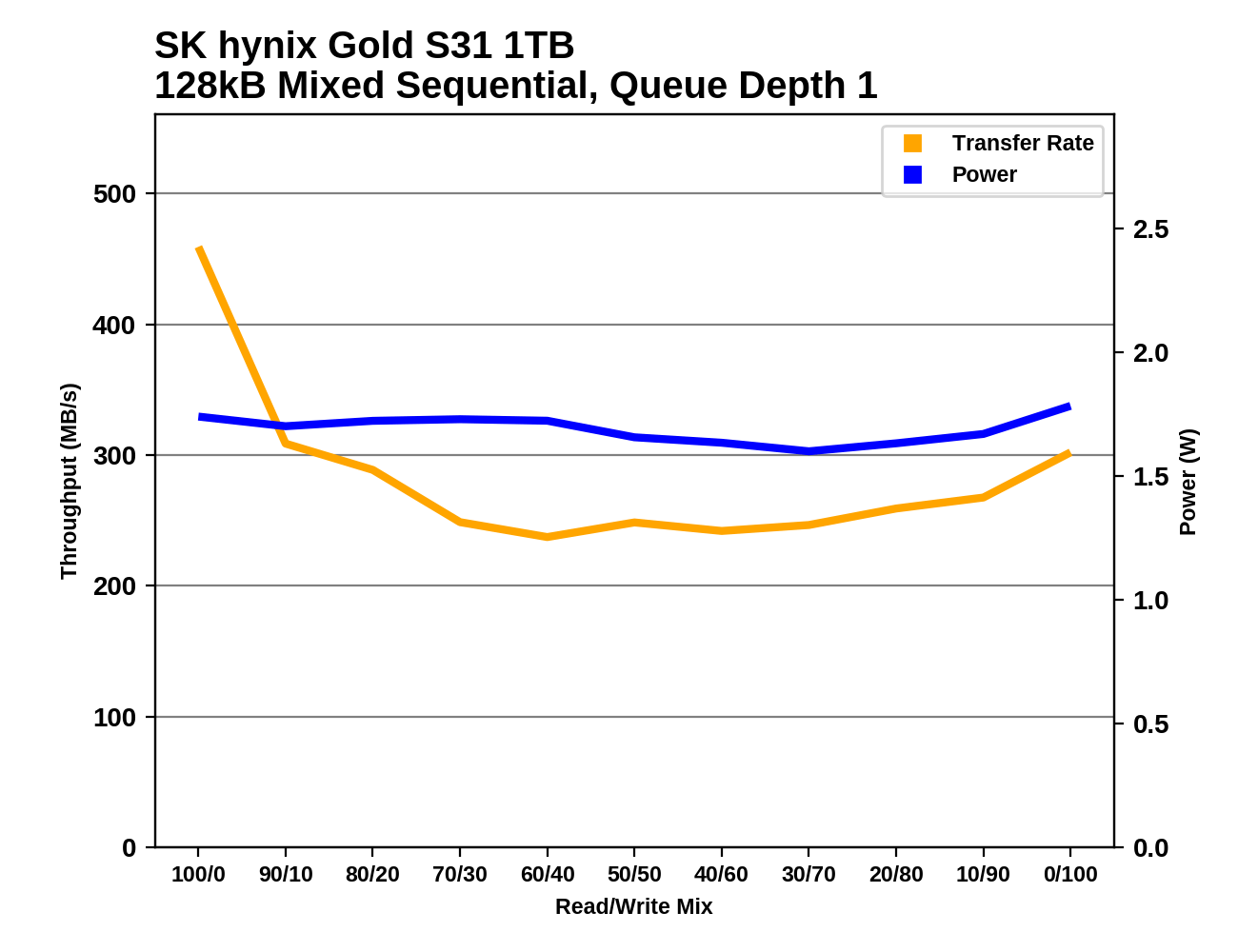The SK Hynix Gold S31 SATA SSD Review: Hynix 3D NAND Finally Shows Up
by Billy Tallis on November 13, 2019 12:00 PM ESTMixed Random Performance
Our test of mixed random reads and writes covers mixes varying from pure reads to pure writes at 10% increments. Each mix is tested for up to 1 minute or 32GB of data transferred. The test is conducted with a queue depth of 4, and is limited to a 64GB span of the drive. In between each mix, the drive is given idle time of up to one minute so that the overall duty cycle is 50%.

All three capacities of the SK Hynix Gold S31 perform fairly well on the mixed random IO test. The 1TB and 500GB models rank just behind their fastest competitors of like capacity, and the 250GB model performs on par with several drives of significantly higher capacity.
 |
|||||||||
| Power Efficiency in MB/s/W | Average Power in W | ||||||||
The three capacities again earn excellent power efficiency scores, second only to Samsung's 860 series drives. In absolute terms, the three are each averaging less power draw than any of the DRAM-equipped drives.
 |
|||||||||
Performance for the S31 on the mixed random IO test increases quickly as the proportion of writes in the workload is increased. As is typical, the test ends with a spike in performance as the workload shifts to 100% cacheable random writes. The 250GB model starts to fall behind after writes account for more than 20% of the workload, and it doesn't really catch up even at the end of the test.
Mixed Sequential Performance
Our test of mixed sequential reads and writes differs from the mixed random I/O test by performing 128kB sequential accesses rather than 4kB accesses at random locations, and the sequential test is conducted at queue depth 1. The range of mixes tested is the same, and the timing and limits on data transfers are also the same as above.

In stark contrast to the good overall performance on the mixed random IO test, the SK Hynix Gold S31 drives are all in the bottom performance tier for the mixed sequential workload test. The 1TB model is basically tied with a DRAMless SSD, and the smaller two are even slower though they outperform the DRAMless drive of similar capacity.
 |
|||||||||
| Power Efficiency in MB/s/W | Average Power in W | ||||||||
Even though performance on the mixed sequential IO test was clearly on the low side, the drives earn power efficiency scores that are only slightly below par. Their power consumption in absolute terms is still a bit lower than most of the competition.
 |
|||||||||
All three capacities of the S31 start out with decent performance with the pure-read workload phase of this test, but performance drops off quickly. The 1TB model spends most of the test hovering around 250MB/s and the 500GB model is a bit slower than that. The 250GB model takes until the 30/70% read/write mix for performance to level out at well under 200 MB/s.










22 Comments
View All Comments
bananaforscale - Sunday, November 17, 2019 - link
And PLC will probably suck even more than QLC.netzflickzz - Friday, October 2, 2020 - link
On the off chance that you are intending to switch the versatile organization, at that point it is the correct opportunity to https://netflicsaccounthack.club/ go for somebody who pays for your Netflix account. T-Mobile has dispatched an arrangement where you can utilize their administrations while profiting Netflix represent free or for an insignificant charge.Charlie22911 - Wednesday, November 13, 2019 - link
How about we get some capacity bumps while we are at it too! I’d love to toss a 4TB QLC m.2 SSD in my laptop, one less thing to carry like the portable rust for my extensive Steam library.eek2121 - Wednesday, November 13, 2019 - link
Your laptop likely has a 2.5" sata bay. I expect we shot ourselves in the foot with m.2. There is quite a bit less space for the nand and controller, and m.2 drives are harder to cool. I personally had to buy a heatsink for my 970 evo.kpb321 - Wednesday, November 13, 2019 - link
At 4tb your drive cost is going to have pretty much linear scaling with the size as the cost of the NAND becomes the dominating factor which is what we see in the pricing chart even for 2.5' drives where space shouldn't be an issue. The 250 gb drives have a higher cost per gb reflecting the costs for the enclosure, the controller and dram, and circuit board. By 512gb or 1tb the cost per gb has become flat. A 4tb M2 drive would be a little bit harder to do than a 2.5' drive but I still think the main limitation is the relatively limited market for 400-500 SSD drives and currently 2.5' drives address more of that market.Death666Angel - Thursday, November 14, 2019 - link
Don't confuse M.2, NVME and SATA. There's a difference between protocoll and form factor. And I have no cooling on 2 out of 3 of my desktop M.2 NVME drives, just normal case ventilation for an upper midrange build, and they are fine around 40 to 50°C idle and never above 60°C when doing things (copy, extract, compress). What sort of situation led to your Evo throttling?firewrath9 - Saturday, November 16, 2019 - link
You can fit the exact same controller, nand, and dram on M.2 ssd as you can in a 2.5" one.Have seen the PCB on any recent SSD, 2.5" or M.2?
Besides, I'd rather have a larger battery, lighter/smaller laptop, or better cooling system or a combination of those than a 2.5" bay.
milli - Thursday, November 14, 2019 - link
Always loved the Corsair Neutron. While not giving peak performance, it gave very stable performance. It seems that this legacy is still existing with this controller.jabber - Thursday, November 14, 2019 - link
I see the moaning comments re. these drives, stagnation, low speeds etc.Then I get handed a customers laptop which still has a 500GB spinner in it and I remember how far from reality some of us have come. You've never had it so good!MenhirMike - Thursday, November 14, 2019 - link
True, but "You've never had it so good!" has been true for decades. That 500 GB spinner is so much better than a 40 GB spinner from a few years before, and despite that 500 GB spinner being the "never had it so good" of its time, we got bigger, faster, cheaper drives.That doesn't mean we should just be happy with what we've got and stop asking for more :) I want to see 5c/GB as soon as possible, 2 TB/$100 drive, and maybe some 4 TB/$200 drive would be welcome.